Then & Now! Julia Butterfly Hill
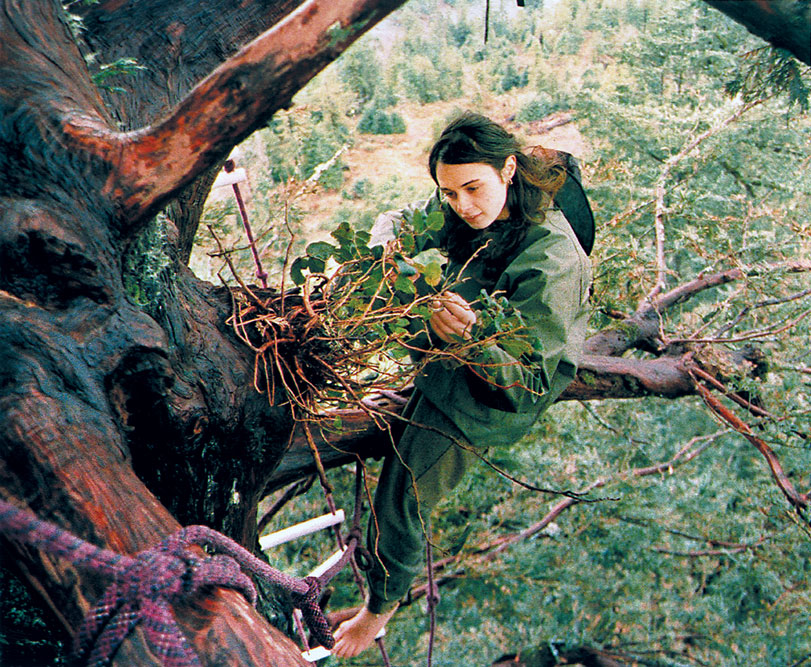
Then & Now!
Julia Butterfly Hill ascended Luna—a giant 1,500-year-old redwood tree near Stafford, California—in December 1997. She lived in Luna for 738 days, until finally descending in December 1999 when an agreement was made with Pacific Lumber Company that protected Luna and a 200-foot buffer zone surrounding the tree.
Julia Butterfly Hill was interviewed on June 23, 2021 by Trees Foundation’s Director of Development and Outreach, Kerry Reynolds. The transcription has been edited for length. You can watch the full 27 minute interview at https://youtu.be/WPnwqKtjLgs.
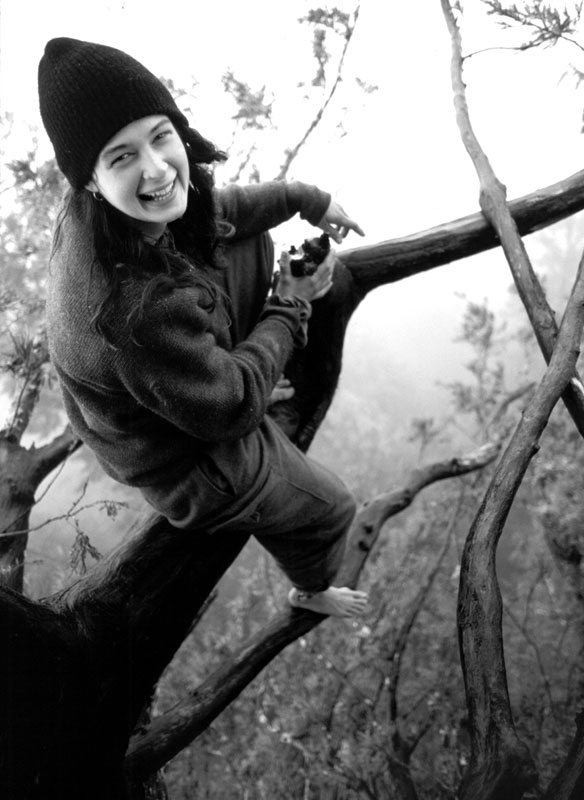
Kerry Reynolds: It’s been over 23 years since you ascended Luna in December of 1997, beginning your two-year treesit. We’re interested in hearing how you’ve been doing and how your work has carried on.
Julia Butterfly Hill: Yeah, it’s amazing how much time has flown by. It’s like, I recently have had to sort through some old files and photos and things, and seeing myself grow up and I do not look like such a baby, and now I have all grey hair. [laugh]
For the first seven years after I came down from Luna, I averaged 250 events a year, so I pretty much hit the ground running. People are always shocked that I’m an introvert, but I’m an extreme introvert. I remind people, like, how long do you think an extrovert would have lasted by themselves in a tree in the middle of nowhere? Only an extreme introvert could do what I did, but then the trees told me when I was up there, they said, “Julia, just like when you go to a new country, you need a translator, nature needs translators…We’ve been communicating since the beginning of time, and people have forgotten how to listen, and they’re going to listen to you, so we need you to do this.”
Honestly, in many ways, becoming a public person was much, much, much harder than all the other stuff I went through in the tree, from them trying to kill me, to nature almost killing me, and everything else—it was becoming public and learning how to communicate. I never even used to talk for years—I could go for hours and hours and hours without saying one word. But because of the attention and energy that came at me, I felt responsible to do something with it.
That’s actually why I started Circle of Life, and part of why I’m so grateful for Trees Foundation. I had a few different opportunities that were going to bring in money, and finally I had a way to try and build a team to help take the energy that was coming at me and project it back out into the world. Because if it just stayed on me, it was the Julia Butterfly show, and I was never interested in that. That’s not why I went through what I went through. I would have come down on day 100 or something. [laugh] I wanted to take that spotlight and all the energy and power, perceived or otherwise, that came with it and use it to make a difference in the world.
So Trees Foundation was actually our first incubator, to help us build and grow. I came from the business world, I had never done non-profit anything, so it was a really big learning curve for me. Without Trees, I wouldn’t have had that capacity to start building upon and leveraging all that stuff that was coming at me.
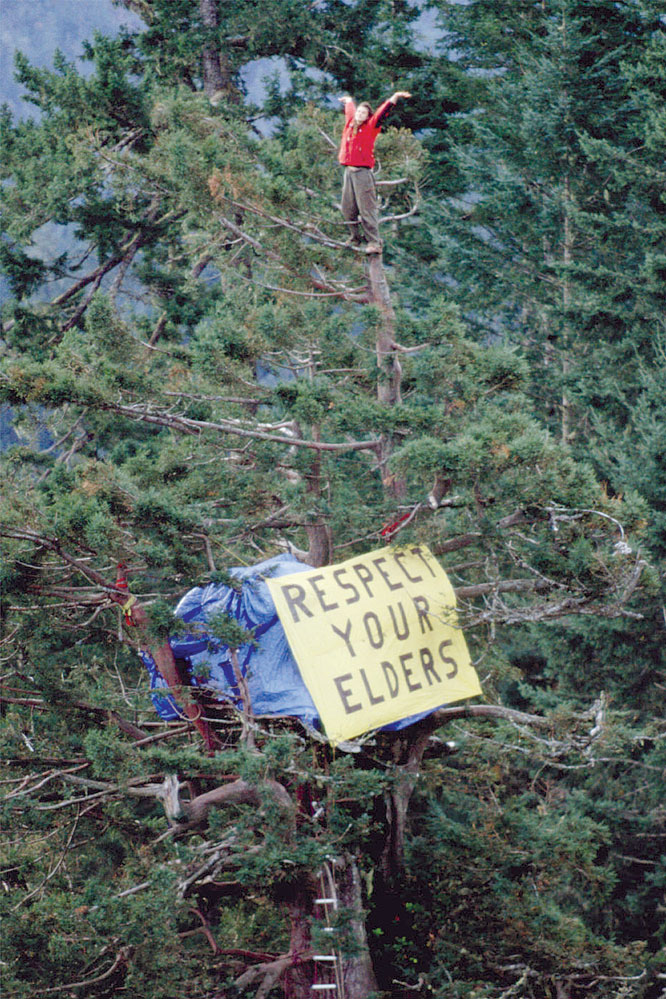
While I was in Luna, I learned that every issue we’re facing is the symptom, and the disease is the disease of disconnect. When we’re disconnected from the Earth and we’re disconnecting from each other, we make choices and don’t realize how it’s truly impacting all of us, and that means all the beings, everything, and the future generations. I wanted to try and help weave that together for people, that if…we’re working on the symptoms, if we don’t work also at the disease, we’ll never be able to get to the healing that our world and our planet needs.
KR: So looking back in 2021, we have such challenges still, and the climate crisis… What would your advice be to someone today who is wanting to protect what we have and restore the ecosystems that are falling apart?
JBH: Well, I would say probably the same thing I’ve been saying for years, which is number one, thank you…If you wake up in the world today for the last long, many years, and you ask yourself, ‘What can I do today to make the world a better place?’ and you care about the world, that’s an act of courage right there. I mean, that is the salmon swimming upstream. [laugh]
I’ve always talked about how the word “courage,” the root word for courage is coeur, from the French, which means “heart.” So any time we are willing to wake up in the midst of all these challenges we are facing and ask ourselves: What would my heart guide me to say, think, and do today about whatever it is—whether it’s the global climate instability, to how we’ve become so disconnected as a human family, where we’re all picking sides and setting up camps and tents and choosing who’s right and who’s wrong.
Whatever it may be, if we wake up and ask ourselves that, we will find a way to sustain, versus if we’re just like, “I hate the corporations” or “I’m mad at the government.” Because that’s how I started in Luna. When I got to the top of Luna for the first time, and I looked and I saw the Maxxam Pacific Lumber Company, no joke, the first words out of my mouth were, “Wow, what I could do with a good rocket launcher from here.” That was my thought, that if we could just take that [the lumber mill] out, the scenery would completely change. Of course, that’s not true, but that was my first reaction, and over time that anger was eating me away, and I also saw it eating away a lot of other activists.
That kind of anger is a candle burning at both ends, and it consumes us and really doesn’t affect or change anything or anyone else but ourselves. So I started telling people—it’s still true for me today—that if you’re not angry at the world, you’re not awake. But do we choose to do what we do out of our anger, or do we choose to do what we do out of our love?
Anger is actually the defense mechanism for us feeling pain about something, someone, or somewhere that we care about that is being hurt, violated, destroyed, or threatened. So when we feel that anger, if we can go beneath it to our heart and put our heart or love into action, then no matter what the outcome, we will be able to sustain because we don’t really know the outcomes.
We protected Luna and the grove around it, and then some angry people, because Luna was a symbol, went and attacked Luna. Even after I came down, I had to have a lot of security for a long time because of how many threats of attacks and attempted attacks that were on me. So ever since I’ve come down, I’ve been able to be a part of a lot of wins, but I’ve also given a whole lot to some things that we’ve lost, and if it wasn’t my heart generating my actions unattached to outcome, I would be depleted and exhausted and not willing to participate any more.
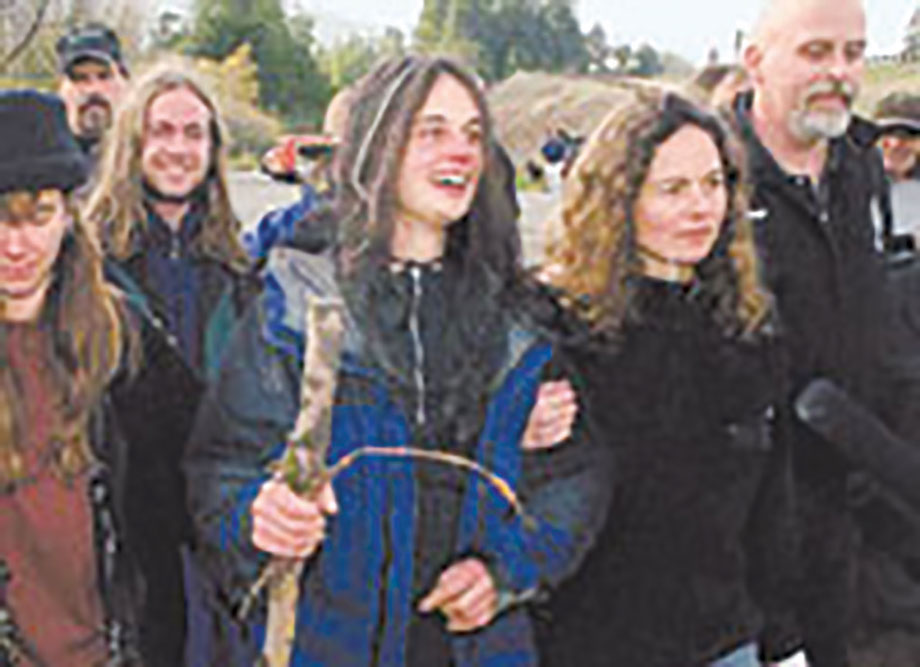
KR: We know that you went through a lot of challenges and trauma while
in Luna, and that you’ve also had some real challenges in the last few years. Can you talk about some of the challenges you’re facing, and maybe some of the projects that you are interested in or are working on?
JBH: Well, unfortunately, I’ve not been able to do as much as I would like because ever since 2014 I’ve basically gotten clobbered by one thing after another after another. My way of dealing with difficulties is humor and it is oftentimes twisted. So I tell people that not only does the universe keep ripping the rug out from underneath me, but then it rolls it up and beats the crap out of me. [laugh]
So I was living in the tropics, which I love. I had so many injuries from before Luna that being in the warmth next to the sea is one of the few places where my body doesn’t hurt… I have severe asthma that got worse after all the inhaling of all that smoke up in Luna from the clearcut burning. But I was getting more and more sick and couldn’t figure out why, and I came back to the United States in 2014 and ended up getting rear-ended twice in two weeks at the end of 2014. I had been hit by a drunk driver and it totaled my body in 1996, which was part of the path that led me to Luna. So the next two [car accidents]…. I had spent all these years building support systems around all the injuries, and so the first hit kind of took the support systems down, then the second hit totaled me. And it did no damage to the car, so no lawyer would take my case, and so the insurance of the woman who hit me paid for the ER visit, and that was it, and it took four and a half years and two hip replacements to be able to move free of pain again.
And so insurance covers doctors’ visits, or physical therapy or prescription medication, but it doesn’t cover chiropractic, it doesn’t cover sports medicine, massage, it doesn’t cover all those things that I had to do to be able to function again. At the same time, my sickness went through the roof, and I figured out (because I’d been misdiagnosed like 10 years earlier) that the illness I had was late-stage Lyme disease. It severely damaged me, gave me a heart attack, made my brain really foggy and messed up for quite some time. There were days where I couldn’t even lift this glass of water. I couldn’t trust that I’d be able to even lift it and not drop it. It was really, really severe.
Then finally, I was starting to get better. I was doing a few projects, I helped with a really cool project in Alabama with a non-profit rebuilding the downtown area in Greensboro, Alabama. It’s built through community ownership so that it can’t get gentrified and bought out. They’re taking buildings that are literally falling apart and using almost all reclaimed and reused and repurposed materials, and winning awards, and building houses for people who don’t have them—incredible work.
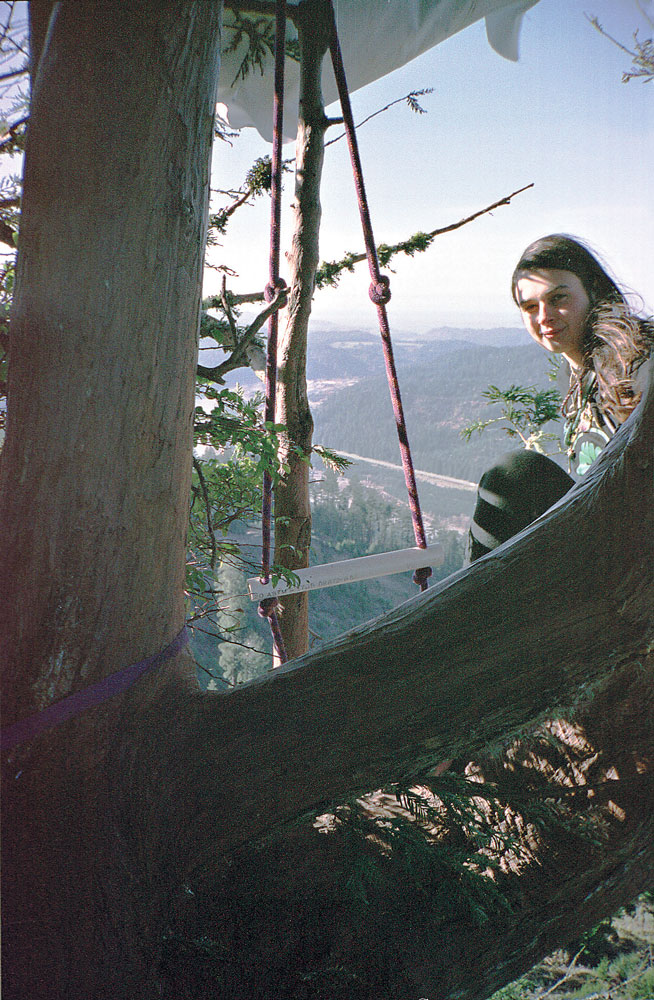
So I’ve done a few things there. I just have been a little bit more from behind the scenes because of all my injuries and illness. Then I finally started feeling better, and then I inadvertently, without ever meaning to or expecting to, met my soulmate. And it blew my heart wide open in a way that’s only comparable to Luna, and six months later, they were dead from cancer. And then I was just stuck for a long time, I just was lost, I could barely get out of bed….
I started doing some odd jobs (I’m very good as a plant-based chef, and I’m good at gardening, designing, and things like that) and then COVID hit. Because of my Lyme disease, I’m a big target for COVID, so I laid low for a long time. Then I came back to the Bay Area where the woman I call my sister lives. I bought a van and was going to convert it as kind of my new living space, but…I was driving my little car, and I was at a stoplight and I got rear-ended for the fourth time, this time in a hit and run. It will be a year ago July 15th, and I still can’t walk longer than 10 minutes without being in pain, and I cannot drive longer than 45 minutes without being in pain. The doctors had said, we’ve done everything we can, it’s just gonna take years of physical therapy and all those things that I’ve been doing for years to get to some point where I won’t hurt as bad. So unfortunately, the news since 2014 has been freaking brutal, but I’ve still been able to help projects that I care about.
KR: Is there a fund or website where people can make donations to support your recovery?
JBH: There is a support button on my website [www.juliabutterflyhill.com] to support my work, but if they need a tax write-off, it would need to go through Circle of Life, and there’s not an email or anything on that website. We closed the public face of [Circle of Life] years ago, because basically it had become the Julia Butterfly Hill fan club, and everybody wanting and needing me and nothing coming in. I was working my butt off to generate the income as well as be everything to everybody. And finally I was like, ‘Why am I doing this?’ I think it’s my heart longing to serve, but the rest of you is like, ‘Girl, you have got to stop.’
[Editor’s Note: To inquire about making a tax-deductible donation through Circle of Life, you may email
[email protected]]
So we closed the public face and then we did a lot of thought and research, and we decided to keep the [nonprofit] status, and it’s been great because we’ve been able to help launch many different projects…We’re fiscally sponsoring a couple that have to do with regenerative farming with Indigenous people and People of Color. One of the things I’ve been passionate about…with the climate is regenerative farming, where we’re actually farming to put carbon back into the soil and create healthy food for communities in need. So we’ve been able to do a lot of really cool things behind the scenes, and that feels like the next stage in the life of Circle of Life.
KR: When you look back on your time in Luna, what are the things that you are most grateful for?
JBH: Well, the one thing I want to make sure and say right now is how grateful I am to the various [members of the] ground support team—especially the last nine months [in the tree], we had a really solid team—and the folks who were working in the office. In all of my talks, I’ve always told people that I might be famous for what I did, but all that means is more people are up in my business. [laugh] But the truth is, without my ground support risking arrest to bring up food and supplies, and pack out waste; and without the people answering the emails and the phone…like now we have phones [that] I could have answered the emails from the tree, but back then, NO. [laugh]
Without each person, we wouldn’t have had the success we had. And I also use that as an example, whenever I’ve done talks, workshops, interviews, anything…people will sometimes look at what I did and say, “Well, I could never do that” and I always tell people, number one: neither could have I. You know, if you had told me on the day that I was standing at the base of that tree, you’re gonna go spend the next two years and go through all this stuff, I would have laughed, I would have screamed, and I would have run back down the mountain, you know? [laugh]
So the first thing I tell people is, our mind is the biggest obstacle. But secondly, I tell people that support team is crucial! So if you’re not the person meant to be in the tree, you are someone who’s meant to support some kind of energy, whatever that may be—for the animals, around nuclear, around climate change, around our children, our elders, whatever it is—every position on the team is vital! Because without it, you don’t have the same strengths.
So that’s what I want to make sure and say thank you to. Just like, thank you to Trees [Foundation] because without Trees [Foundation] being that bridge for me, all the attention and energy was coming at me, and we would NOT have been able to do the same kind of work we were able to do with the help of Trees.
Every single person was vital to the success and continues to be. Stewart [Moskowitz] is the ongoing angel of Luna; Sanctuary Forest is holding the covenant agreement—like, the team continues! [laugh] And who knows what that team will be like in 100 years…There’s a million things I could be grateful for, but I think the thing that’s most important for me to say is thank you to this team and how important team is, and how there is a role on EVERY team for EVERY one.
KR: It’s hard for people today to understand even just how diverse that network of groups was. There was Trees Foundation, there was Earth First!, Sanctuary Forest, EPIC, others I’m sure, all working all together. It couldn’t have been easy.
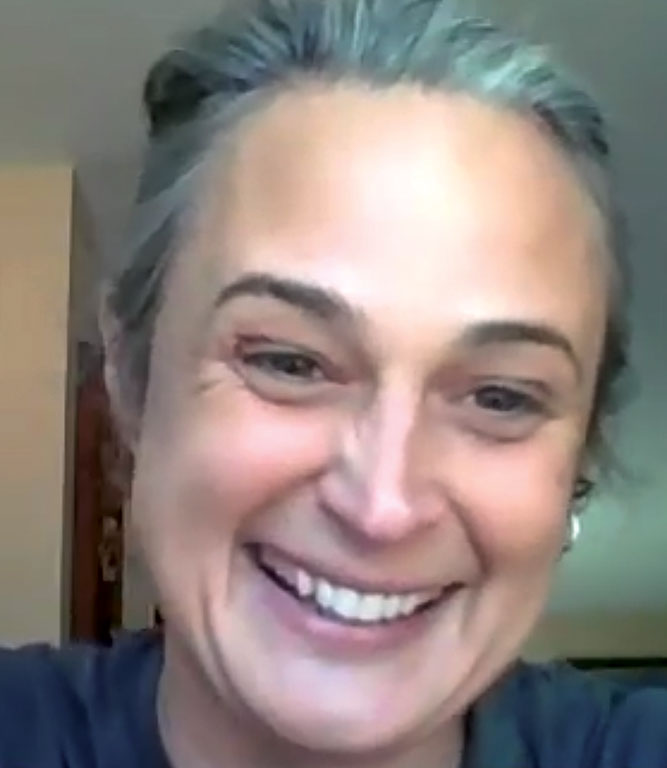
JBH: The diversity of people involved created some real challenges, but it was also one of my greatest teachers. It’s like, if nature needs diversity in order to be beautiful and healthy and strong, then we need the same thing for our movements. And even if we don’t all AGREE, we have to find a way to be different and still be okay with that, and find ways to support one another in our growth, and our beauty, in our health for our communities.
It was a really special time. Clearly, the universe and Luna called me at just the right time. If there hadn’t been all that work done up to the point where I came along, who’s to say what would have happened? If there hadn’t been all the work done by all the different groups while I was in the tree, who’s to say what would happen?…We don’t even have a way of calculating—this line goes with that, that line goes to that one—it’s a ripple that spread around the world and continues to.
The story continues—it’s taught in classrooms—it just has a life that is so much bigger than me, and in part it’s because of the “we”… We can’t put in a chart or graph how important our work was and is, but it is clear that it was all important. [It’s like] when you have a really healthy soil, everything that grows out of it is going to be healthy, and a bird can fly by and drop the seed and it
will grow… .
All of us together built this soil that all this stuff continues to grow from. Even when Luna got cut, incredibly diverse people from all walks of life came together to save Luna because Luna had become the symbol of what it means to be connected to one another, even when it’s challenging. To me, that is a beautiful legacy of both. If the disease is the disease of disconnect, then the healing is all the ways that we can, and do, connect.
